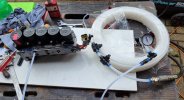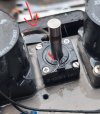It’s been a week or two since I’ve been at this (HEVAC problems too) but I was wondering about the NRV and diaphragm in the exhaust so to try and rule them out I had the valve block out last night and replaced the diaphragm valve again with one from LandyAir since their valve comes with the large washer type fitting all ready pre fitted, and then I also checked the NRVs, which looked to be in excellent shape and had no misshapen heads or anything. Ran up to pressure and this morning, say 14 hours later or so, I’ve gone from 140 psi to 55 psi. The battery has been disconnected in this time too as I’ve had air bags in and out with the dash so the height isn’t self adjusting down and I’ve lost no height in the corners, just a loss of pressure at the tank reservoir. I’m really at a loss as there’s still no sign of a leak anywhere and I was confident a new diaphragm would cure it


